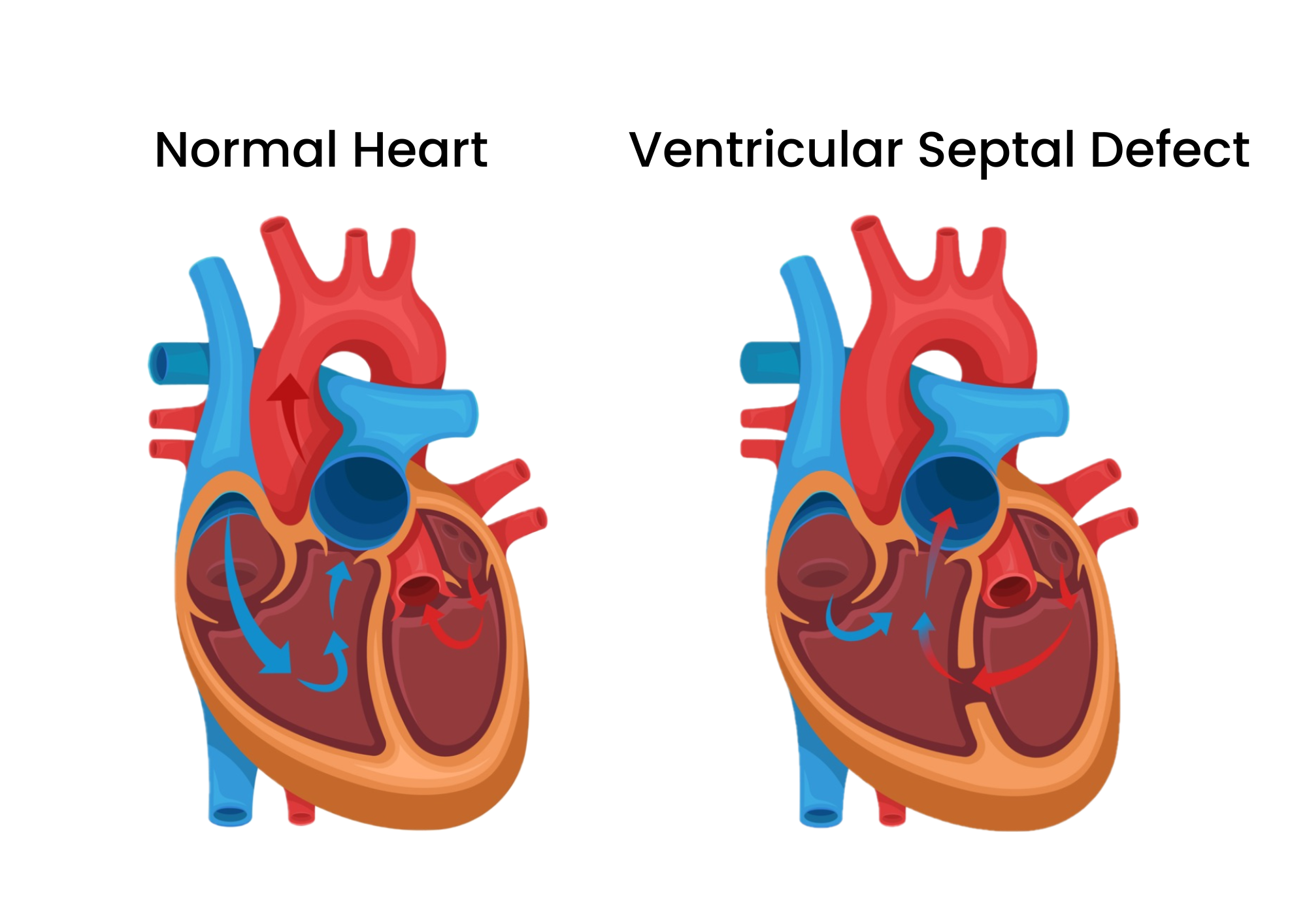What is - Ventricular Septal Defect

Possible complications of Ventricular Septal Defect (VSD)
- Enlarged heart: Due to the additional blood volume recirculation and increased workload of the heart.
- Pulmonary hypertension: High blood pressure may build up in the lung arteries from the increased blood flow to the lung.
- Heart failure: The heart has to work harder, resulting in a large amount of blood being pumped to the lungs. This can eventually lead to heart failure.
- Abnormal heart rhythms/Arrhythmia: In some cases, VSD might lead to irregular heart rhythms.
- Endocarditis: This heart infection is a possible complication of VSD though it is rare.
- Aortic regurgitation: Leakage of blood through the aortic valve.
- Double chamber right ventricle: Abnormal muscle growth in the right ventricle resulting in two separate right ventricular pressure compartments.
Ventricular Septal Defect (VSD) classification
Symptoms of Ventricular Septal Defect
- Shortness of breath or quick breathing
- Sweating
- Fatigue while eating or playing
- Poor appetite or weight gain
- Breathlessness
- Palpitations (abnormal sensation of the heart beating)
- Lower limb swelling
- Syncope (fainting)
- Giddiness
- Chest pain
Ventricular Septal Defect - How to prevent
Ventricular septal defect (VSD) is congenital and thus, it is difficult to prevent your baby from having this condition. However, a healthy pregnancy is still crucial to minimising the risks of VSD. Here are some steps you can take:
- Avoid harmful substance like alcohol, tobacco and illicit drugs.
- Make sure you keep up to date with your vaccinations to avoid infections that can be harmful to a developing fetus.
- Speak with your doctor early to get prenatal care and supplements even before you get pregnant. Discuss your current health, lifestyle and medications with your doctor. He/she will then provide you with advice for a healthy pregnancy.
- Eat a balanced diet and exercise regularly.
- Manage diabetes well if you have the condition and work closely with your doctor to keep it under control before getting pregnant.
Ventricular Septal Defect - Causes and Risk Factors
Ventricular septal defect (VSD) is a congenital heart defect which means that problems occur during the early stages of the heart’s development. Although genetic and environmental factors have been found to contribute to the presence of VSD, no clear cause of VSD has been found. Generally, genetics are recognised as the biggest risk factor for VSD and it can be associated with other genetic problems as well. In rare cases, VSD can also be developed later in life as a result of a heart attack or previous heart procedures.
Diagnosis of Ventricular Septal Defect
- Cardiac catheterisation: A thin, flexible tube (catheter) is inserted into a blood vessel and guided into the heart. This allows the doctor to determine if a VSD is present and whether the heart is functioning well.
- Chest X-ray: This allows the doctor to see if the heart is enlarged or if the lung has excess fluid.
- Echocardiogram: This is an ultrasound scan of the heart that can be conducted on a fetus. It shows any issues with the heart structure. It can also determine the position, size and severity of the VSD.
- Electrocardiogram (ECG): This helps detect any heart defects or abnormal heart rhythms (arrhythmia) by measuring the heart’s electrical activity.
- Cardiac MRI: This allows the doctor to measure the size of the heart and how much blood is flowing across the VSD.
Treatment for Ventricular Septal Defect
Medications
Surgeries or procedures
Ventricular Septal Defect - Other Information
Living with Ventricular Septal Defect (VSD)
Activity
Most patients do not need to restrict their activity. Your doctor will determine if you are required to restrict your activity.
Prevention of Infective Endocarditis (IE)
Family planning and pregnancy for women with Ventricular Septal Defect (VSD)
Cardiac-Obstetric Clinic
NHCS Adult Congenital Heart Disease (ACHD) Programme
- ACHD clinic on every Wednesday and Thursday afternoon, and on the first and third Fridays of the month in which an average of 20-30 patients are seen at each session. Besides offering care and follow up of ACHD patients, NHCS also does screening of suspected Marfan patients; close monitoring of ACHD patients during pregnancy (see Pregnancy and Women with CHD) and a monthly joint Cardiac Obstetric Clinic (every last Monday of the month) with obstetricians from Singapore General Hospital (SGH) ; Monthly Transition Clinic in KK Women's and Children's Hospital (KKH) run jointly with paediatric cardiologists from KKH for patients above the age of 16. The aim is to give paediatric patients a smooth transition from paediatric cardiology to adult cardiology services. An average of 100-150 teenagers with congenital heart disease are transferred from KKH to NHCS every year. There is also a monthly Pulmonary Hypertension Clinic (every second Friday of the month) run jointly with a respiratory physician and a rheumatologist from SGH for general as well as congenital patients with severe pulmonary hypertension.
- Dedicated twice weekly congenital echocardiography sessions.
- Dedicated weekly congenital cardiac catheterisation and intervention (particularly atrial septal defect (ASD), patent foramen ovale (PFO) and patent ductus arteriosus (PDA) device closure).
- Surgical interventions including extra-cardiac Fontan procedures for uni-ventricular hearts, pulmonary homograft replacements for Tetralogy of Fallot patients with severe pulmonary regurgitation, Rastalli conduit for patients with pulmonary atresia.
- Expertise in nuclear imaging, magnetic resonance imaging (MRI) and multi-slice computed tomography (CT) imaging.
- Expertise in pacing, arrhythmia treatment and ablation in congenital patients.
- Expertise in cardiopulmonary and exercise testing.
- Expertise in heart and lung transplantation for selected patients with end-stage congenital heart disease.
- Dedicated ACHD nurse for education, support and care of ACHD patient and their families.
Adult Congenital Heart Disease (ACHD) Clinic
Contributed by
The information provided is not intended as medical advice. Terms of use. Information provided by SingHealth.
Get to know our doctors at SingHealth Hospitals in Singapore.
Get to know our doctors at SingHealth Hospitals in Singapore. here.




















